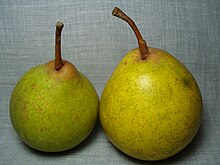German national bergamot
The German national bergamot or “national bergamot”, “Belle sans Pépins”, “Belle et Bonne” or “ pear without seeds” is one of the bergamot pears and autumn pears. It probably comes from France , as it was already known there in 1802. As a pear variety that is not very demanding in terms of soil and climate, the German national bergamot is now mainly grown in high altitudes such as the Alps and the Black Forest.
description
tree
The tree grows vigorously and forms a broad pyramidal crown . The annual shoots are greenish to reddish brown. The variety is considered very fertile.
fruit
The fruit stalk is medium to long and slightly curved. The fruit is medium to large in size and rounded in the shape of a bergamot with a light green skin, and yellow-green when fully ripe. The calyx is small, half-open, with short horn-like sepals . There is a handle pit, it is slightly rusted. Ripeness begins in early to mid-September and the fruit can be kept for around two to three weeks. The flesh is yellowish-white, fine-celled and melting, sweet without much spice.
See also
literature
- Walter Hartmann (Ed.): Color Atlas of Old Fruit Types. 2nd, heavily revised edition. Ulmer, Stuttgart 2003, ISBN 3-8001-4394-1 .
- Franz Jahn , Eduard Lucas , Johann Oberdieck : Illustrirtes Handbuch der Obstkunde. Volume 2: pears. Ebner & Seubert, Stuttgart 1860, No. 32, pp. 87-88 .
- Willi Votteler : Directory of apple and pear varieties. 1360 variety descriptions, 3340 double names. 4th edition. Obst- und Gartenbauverlag, Munich 1998, ISBN 3-87596-086-6 .
Web links
- Index card of the variety in the BUND-Lemgo fruit variety database .
- Entry of the national bergamot in the Swiss National Database .


